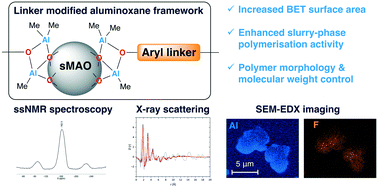Polymethylaluminoxane organic frameworks (sMAOF) – highly active supports for slurry phase ethylene polymerisation†
Abstract
A series of modified solid polymethylaluminoxane (sMAO) catalyst supports have been developed for slurry phase ethylene polymerisation, using aryl di-ol modifier groups. Characterisation using ICP-MS analysis, X-ray total scattering, SEM–EDX, diffuse FT-IR and solid state NMR spectroscopy shows that the organic linker groups are uniformly distributed in a proposed organic framework stucture we call a “sMAOF”. When used as a support for rac-ethylene{bis(1-indenyl)} zirconium dichloride, (EBI)ZrCl2, these linker modified sMAOF materials provide a 40% enhancement in polymerisation activity with respect to unmodified sMAO: activities of 163 × 103 and 116 × 103 kgPE molZr−1 h−1 at 80 °C for (EBI)ZrCl2 supported on sMAOF(1,4-HO(C6F4)OH) and sMAO, respectively. The observed activity increase is correlated with the higher BET surface area and increased porosity in the linker modified sMAOF activating support.



 Please wait while we load your content...
Please wait while we load your content...